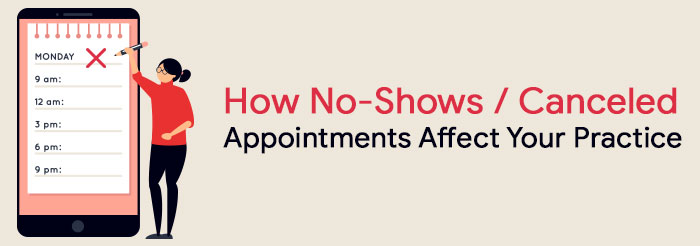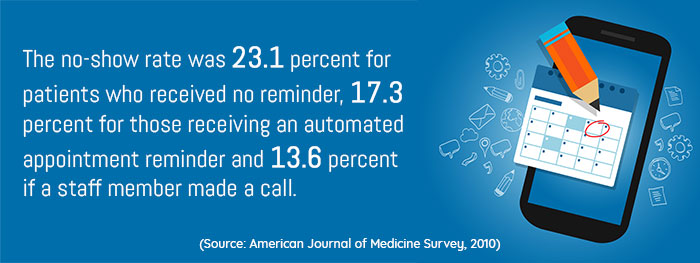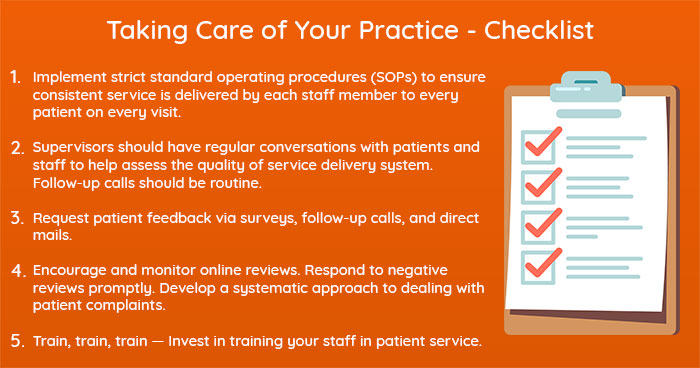How No-Shows/Canceled Appointments Affect Your Practice
Posted on
Let’s face it: Every medical practice has appointment cancellations and no-shows. As a healthcare marketer, you must be aware of the high cost of no-shows and cancellations: decreased revenue, underutilized staff, lost commissions and decreased staff morale. If not addressed properly, appointment cancellations and no-shows can add up to revenue losses, estimates pointing to an average of $40,000 to $60,000 per year.
According to SCI Solutions, the healthcare technology company, missed appointments cost the U.S. healthcare system more than $150 billion per year and can cost a doctor an average of $200 per unused time slot.
Look at this example. If your medical practice averages two cancellations or no-shows in a day, at a value of about $100 to $125 for each appointment, you are losing more than $40,000 a year. If this figure does not scare you, then let us remind you that this number does not include the loss of thousands of dollars where you never had the chance to diagnose a patient.
What Is a No-Show?
It is a non-attending patient who neither uses nor cancels his or her appointment. A missed appointment may seem like an everyday thing. The problem is, most people have no idea of the impact of this problem. According to a survey, nearly 42 percent of patients skip their appointments.


A no-show or a canceled appointment is more than just a missed opportunity. When patients do not show up, it affects people who could have been given the appointment instead of that patient.
While it is easy to blame patients or scheduling conflicts for no-shows and cancellations, the reasons are much more complex. The most obvious reason is financial. When people find out the amount they need to pay for their healthcare, it may seem like too much to them. Some patients also get discouraged by long wait-times at hospitals.
Other reasons for not showing up may include poor knowledge, which means that patients have a limited understanding of what is going on within their bodies. In addition, in the US alone, more than 3.6 million people cancel or delay their medical appointments due to transportation issues. Be it a flat tire or the unavailability of a cab, people tend to miss appointments despite their best intentions.

Lastly, let us not forget about forgetting. Human memory is quite selective when it comes to what we should and should not remember. This could be the reason almost 23 percent of patients do not show up unless they are reminded about their appointment.
Impact of Missed Appointments
Simply, doctors lose their valuable time every time a patient decides to default. It may not sound so terrible, but in the world where time is money, missed appointments are more than just inconvenience. It is estimated that surgeons lose up to 500 dollars per missed visit. This number is not exclusive to surgery.

Costs incurred due to no-shows happen across specialties and locations, regardless of the size of the healthcare facility. Different specialties have different no-show rates. It can be as low as 10 percent for dental practices and as high as 37 percent for mental healthcare facilities. Irrespective of the number, no-shows are impacting your bottom line.

Now that we have outlined the problem, what is the solution?
One way doctors can make patients remember their appointments is by making reminder calls. An SMS notification can also go a long way, but there are effective alternatives to sending text messages.
According to studies, calls are more effective than leaving voicemail messages for helping patients remember their appointments. Almost 17 percent of patients are likely to forget their appointments when they are left a recorded message compared to 13 percent of patients who received a call. But the biggest problem with live calls is that they eat up a lot of time and are often made during busy hours, which can make your staff lose their focus and time. So, even at their most effective, reminder calls may not be the best route to take.
A number of medical practices even try to fine patients who do not show up, just to recoup some of the losses. While this can ensure some returns, and even discipline in some cases, overall it is more like a bandage than a cure.
Tips for Decreasing No-Shows/Cancellations
If you want to have a thriving practice, you must reduce the number of no-shows and cancellations that leave your appointment schedule with gaping holes, making it difficult for you to meet numbers. It is important to note that you will never be able to eliminate cancellations and no-shows entirely. However, if you follow these tips, you will significantly reduce them.

Educate your patients: The fact is, unaware patients are less likely to show up for their scheduled appointments. It is important to take the time to educate your patients about the value of their health. Look for opportunities to provide this education in every interaction with patients. But how can you do this? Offer them brochures, show them educational videos, use images and graphics to show them what’s going on in their bodies. This will help them understand the need for treatment. Answer all of their questions, and make sure they understand the consequences of not adhering to recommended treatment.
Explain your services: Talk to patients about the value of the services you offer, how unique your services are compared to competitors and make sure they understand how important it is to maintain their health and to show up for their appointments. During their visit, give them a brief of every service you will be providing and every product you will be giving them. This will help them understand the importance of the visit an may make them less likely to cancel their next appointment.
Work on your appointment schedules: Do not rely on preappointing alone. It is very much possible that your patients have no idea what they are doing on a Wednesday morning three months from now. So if you are scheduling patients that far out, it is very likely something will come up that may prevent them from keeping their appointment. Instead of relying only on preappointing, consider implementing a hybrid appointment system. You can consider preappointing only reliable patients and flag patients who have at least three no-shows as unreliable. Make it a point to call these patients before their appointment rather than scheduling months in advance.
Always send appointment reminders: Train your scheduling coordinator to confirm appointments three days in advance. You must ask patients for their preferred method of contact – whether they would prefer a phone call, a text message or an email. If a patient prefers a phone call, make sure your staff understands that leaving a voicemail may not be enough. It is crucial that your staff actually talk to the patient to confirm the appointment time.
Create a broken-appointment policy: If you do not have one already, now is the time to create a broken-appointment policy and communicate that policy to both new and existing patients. If your patients know your practice has a broken-appointment policy, they will be less likely to cancel without giving you sufficient notice. You must remind patients of your policy every time they make an appointment. You may decide to waive the fee for the first canceled appointment and charge a repeat offender.

Conclusion
No-shows essentially mean missed care.
Reducing no-shows and canceled appointments will increase patient retention and help grow your practice. Treating a full patient load each day allows your practice to remain profitable while ensuring you are able to serve as many patients as possible.

 Reaching The Right Audience Through Target Marketi..
Reaching The Right Audience Through Target Marketi.. Key Elements Affecting Your Website’s Performanc..
Key Elements Affecting Your Website’s Performanc.. Proactive vs. Reactive Healthcare: Deep Guide
Proactive vs. Reactive Healthcare: Deep Guide